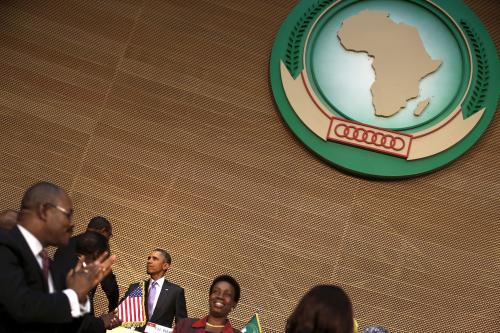This piece is based on a FHI 360 podcast episode on the formation and future of the Sustainable Development Goals.
While the U.S. played an active and major role in creating and adopting the internationally agreed Sustainable Development Goals (SDGs), the America First foreign policy of the Trump administration has called into question the value of global governance and deepened skepticism of United Nations edicts. This especially threatens one of the revolutionary tenets of the SDGs: universality, the application of the SDGs in every country no matter their level of development, the U.S. included.
Yet the SDGs have become the DNA of global development, even in the absence of active U.S. government support. Whether a dividend of the inclusive and transparent process used to create the goals, or the staying power of well-executed branding campaign, those 17 colorful icons, as seen below, are the backdrop—and the frame—on most of the world’s stages where global development is being discussed or debated.

This has made the SDGs attractive to an array of U.S. stakeholders with a global outlook. So while the U.S. government has gone largely silent on the SDGs, leadership from others—businesses, cities and states, philanthropy, and others—is emerging to fill the void
U.S. corporations, for example, are aware that customers and shareholders are increasingly viewing their actions through a lens of moral leadership (witness their public actions after the violent events in Charlottesville). Aligning their business operations with the SDGs helps demonstrate this social consciousness. There is also a growing recognition that areas where commercial interests overlap with development imperatives can provide a competitive advantage.
Venerable brands such as Citi, MasterCard, and Coca Cola are mapping corporate initiatives to the goals. CEOs, investors, and other business leaders seek out the opportunity to elevate the SDGs at events like the Bloomberg Global Business Forum and the Concordia Annual Summit, both held around the U.N. General Assembly.
U.S. philanthropy is also paying attention. The SDG Philanthropy Platform, a collaborative platform that helps foundations coordinate and maps funding flows to the SDGs, continues to add data and tools. The Council on Foundations, the sector’s umbrella association, has hosted a series of meetings across the U.S. to increase awareness of the goals and their potential applicability to the local work of foundations in the U.S.
Some of these meetings have taken place in locations such as Jacksonville, Florida; Albuquerque, New Mexico; and Little Rock, Arkansas. This has been a helpful spur to demonstrating how the SDGs apply to a U.S. local context. This complements cities such as New York, San Jose, and Baltimore, which have developed sustainable development plans that align with the SDGs.
Universities are starting to explore how to leverage the many different nodes of activity happening on campuses throughout the U.S., efforts such as the first Colorado Solutions Summit, hosted by Project X-ITE at the University of Denver to support business start-ups with a social mission that contributes to the goals. The Association of Public and Land-grant Universities recently convened discussions among faculty and administrators about the role their universities can play in advancing the SDGs, both in the U.S. and globally.
While the SDGs have become the DNA of development, universality has not yet become the DNA of the SDGs. Cities, states, businesses, universities, social entrepreneurs—these may ultimately prove to be the dominant leaders in making the universal application of the SDGs meaningful, as they find it natural to cross political and national boundaries to share lessons and successful models.
These efforts are still emerging, and there is no collective arrangement in the U.S. analogous to the coordinated action that has surfaced among multiple stakeholders in reaction to President Trump pulling the U.S. out of the Paris climate agreement. These efforts will also need to grow in seriousness and scope if the U.S. and the world is to meet the SDGs by the target year 2030. Yet while the U.S. government is absent, U.S. leadership on the SDGs is not, and all indications point toward the potential for its continued growth and influence.










Commentary
US non-federal stakeholders starting to fill the leadership gap on the SDGs
November 17, 2017